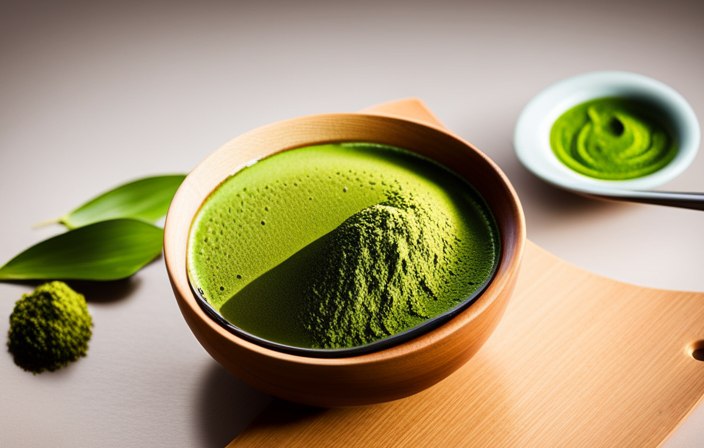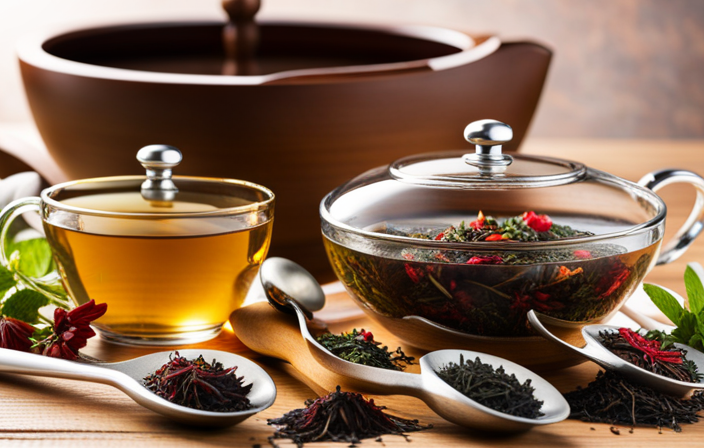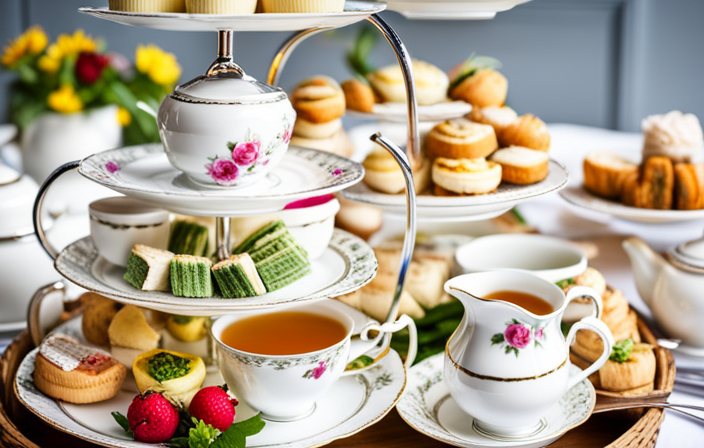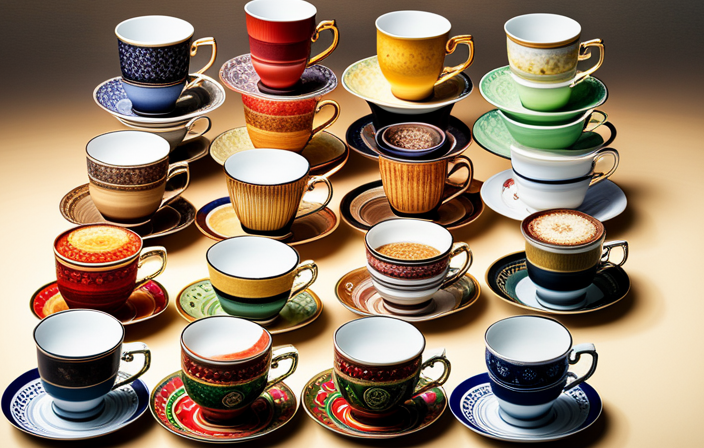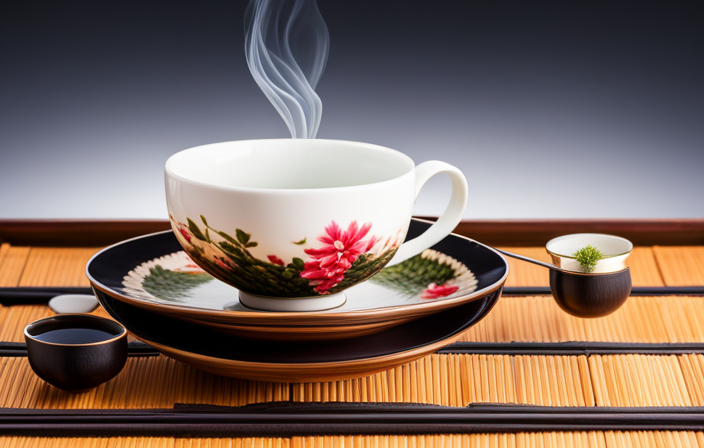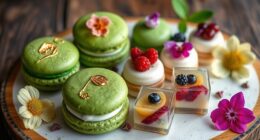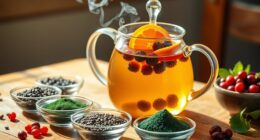I absolutely love matcha tea! It’s not just any green tea—it’s a powerhouse of flavor and health benefits.
In this article, I’ll share with you eight noteworthy facts about matcha tea that will blow your mind. From the meticulous processing method to the cultural significance, we’ll explore it all.
So grab a cup of matcha, sit back, and get ready to discover why this vibrant green drink is taking the world by storm. Let’s dive in!
Key Takeaways
- Matcha tea is made using a traditional stone-grinding process, which retains the nutrients and flavors of the leaves.
- Matcha tea offers numerous health benefits, including boosting metabolism, improving mental alertness, and reducing stress and anxiety.
- Matcha tea can be used in cooking and baking, enhancing the taste and presentation of dishes.
- When choosing matcha, it is important to look for reputable brands that prioritize quality, vibrant green color indicating freshness, and consider matcha from regions like Uji and Nishio in Japan for superior quality.
The Processing Method of Matcha Tea
I learned about the traditional stone-grinding process used in the making of matcha tea. Matcha is known for its vibrant green color and unique flavor.
To produce high-quality matcha, farmers cultivate the tea plants using traditional farming methods. They carefully shade the plants for several weeks before harvesting the leaves. The shading process enhances the flavor and increases the chlorophyll content, giving matcha its distinctive green hue.
After harvesting, the leaves are steamed, dried, and then ground into a fine powder using granite stone mills. This labor-intensive process ensures that the leaves retain their nutrients and flavors.
The resulting matcha powder is then used to make ceremonial matcha, a highly prized and revered tea used in traditional Japanese tea ceremonies.
Health Benefits of Matcha Tea
Drinking matcha tea regularly can provide numerous health benefits, such as boosting metabolism and improving mental alertness. Matcha is a powdered form of green tea that’s made from the leaves of the Camellia sinensis plant. Unlike regular green tea, matcha is made by grinding the whole tea leaves into a fine powder, which allows you to consume the entire leaf. This means that you get all the nutrients and antioxidants that the tea has to offer.
One of the key health benefits of matcha tea is its ability to boost metabolism. Matcha contains a unique compound called catechins, which have been shown to increase thermogenesis, or the body’s ability to burn calories. This can help with weight loss and weight management.
In addition to boosting metabolism, matcha tea can also improve mental alertness. The combination of caffeine and the amino acid L-theanine found in matcha can help to increase focus and concentration. L-theanine has a calming effect on the brain, which can help to reduce stress and anxiety.
Traditionally, matcha tea is prepared by whisking the powder with hot water until frothy. This ensures that you get the full flavor and health benefits of the tea. However, matcha can also be used in cooking and baking, adding a unique flavor and vibrant green color to dishes.
How to Make Matcha Tea
To make matcha tea, start by sifting 1-2 teaspoons of matcha powder into a bowl to remove any clumps.
Then, add hot water that’s around 175°F to the bowl and whisk vigorously in a zigzag motion until frothy.
Traditional Preparation Methods
One important step in traditional matcha preparation involves sifting a small amount of matcha powder into a bowl. This helps to break up any clumps and ensure a smooth and consistent texture. Traditional preparation techniques for ceremonial matcha require attention to detail and precision. Here are some key steps to follow:
- Begin by warming the bowl with hot water, then dry it thoroughly.
- Measure the desired amount of matcha powder into a sifter and gently sift it into the bowl.
- Use a bamboo whisk to slowly add hot water and whisk in a zig-zag motion until the mixture becomes frothy.
By sifting the matcha powder, you ensure that it’s free from any lumps and that it dissolves easily. This allows for a more enjoyable and authentic matcha drinking experience.
Now, let’s move on to the equipment needed for brewing matcha tea.
Equipment Needed for Brewing
I can brew matcha tea using just a few essential tools, such as a whisk and a strainer. These tools are essential for achieving a smooth and frothy cup of matcha. The whisk, known as a chasen, is used to whisk the matcha powder and hot water together, creating a creamy and rich texture. The strainer, on the other hand, helps to remove any clumps or impurities from the matcha powder, resulting in a smoother and more enjoyable tea.
Here is a table showcasing the essential tools for brewing matcha tea:
| Essential Tools |
|---|
| Whisk (chasen) |
| Strainer |
| Bowl |
| Scoop |
| Measuring spoon |
Each of these tools plays a crucial role in the brewing process, ensuring that the matcha is properly prepared and enjoyed to its fullest potential. By using these tools and following the proper brewing techniques, you can create a delicious and authentic cup of matcha tea.
Variations of Matcha Recipes
As a matcha enthusiast, I love experimenting with different ingredients and flavors to create unique and delicious variations of matcha recipes. One of my favorite combinations is adding coconut milk and honey for a creamy and sweet twist.
Here are three sub-lists of variations you can try:
-
Matcha Smoothies:
-
Blend matcha powder, banana, spinach, almond milk, and a touch of honey for a nutritious and energizing smoothie.
-
Mix matcha powder, pineapple, coconut milk, and a splash of lime juice for a tropical and refreshing smoothie.
-
Combine matcha powder, strawberries, Greek yogurt, and a drizzle of maple syrup for a creamy and fruity smoothie.
-
Matcha Desserts:
-
Bake matcha powder into cookies or cakes for a subtle earthy flavor.
-
Make matcha-flavored ice cream or pudding for a creamy and indulgent treat.
-
Whip up matcha-infused chocolate truffles for a rich and decadent dessert.
These variations are just the beginning of the innovative uses of matcha tea in cooking.
Innovative Uses of Matcha Tea in Cooking
I’ve discovered some really interesting ways to use matcha tea in cooking that go beyond just drinking it.
One unique application is incorporating matcha into savory dishes, like using it as a seasoning for roasted vegetables or mixing it into salad dressings.
It adds a subtle earthy flavor and a vibrant green color that can really elevate the taste and presentation of a dish.
Unique Culinary Applications
Using matcha tea as a natural food coloring is a unique culinary application that adds a vibrant green hue to baked goods. This culinary creativity not only enhances the visual appeal of desserts but also introduces unexpected flavors.
Here are three noteworthy facts about using matcha tea in cooking:
-
Matcha tea is made from finely ground green tea leaves and has a rich, earthy taste that complements a variety of sweet treats.
-
It’s commonly used in traditional Japanese desserts like matcha-flavored mochi, matcha ice cream, and matcha cookies.
-
Matcha tea not only adds color and flavor but also provides health benefits, as it’s packed with antioxidants and contains caffeine for a gentle energy boost.
Enhancing Savory Dishes
I can definitely see how incorporating matcha tea into savory dishes would add an intriguing and unexpected twist to traditional recipes. Matcha, with its vibrant green color and earthy flavor, has the potential to elevate the taste and presentation of various dishes.
When combined with savory flavor combinations, matcha can create a unique and memorable culinary experience. Its umami-rich profile enhances the depth of flavors in dishes like matcha-infused sauces, dressings, and marinades.
Matcha can also be used as a rub for meats or sprinkled on top of roasted vegetables for added complexity. The bitter notes of matcha balance well with the richness of savory dishes, making it a versatile ingredient that can be used to create both comforting and refined umami-rich dishes.
Tips for Choosing High-Quality Matcha
There are several key factors to consider when selecting high-quality matcha.
-
Look for reputable brands: It’s important to choose matcha from trusted brands that prioritize quality and source their tea from reputable tea farms. This ensures that you’re getting a product that has been carefully cultivated and processed.
-
Identify fresh matcha: Freshness is crucial when it comes to matcha. Look for vibrant green color, as this indicates that the tea is young and hasn’t oxidized. Avoid matcha that appears dull or brownish, as it may be stale or of lower quality.
-
Consider the origin: Matcha from Japan, particularly from regions like Uji and Nishio, is highly regarded for its superior quality. Japanese matcha is known for its smooth taste and rich umami flavor.
Matcha Vs. Green Tea: What’s the Difference
One key difference between matcha and green tea is that matcha is made from whole tea leaves, while green tea is made from steeped tea leaves. Matcha is a powdered form of green tea that’s made by grinding the leaves into a fine powder. This allows you to consume the entire leaf, which means you get more of the health benefits that green tea has to offer.
Matcha is rich in antioxidants, which can help protect your body against damage from free radicals. Green tea also contains antioxidants, but since it’s steeped, you may not get as many of these beneficial compounds.
Both matcha and green tea have been linked to various health benefits, including improved brain function, increased fat burning, and reduced risk of certain diseases. So whether you choose matcha or green tea, you can enjoy a delicious and healthy beverage.
Understanding the Caffeine Content in Matcha Tea
Matcha tea contains caffeine, so it can provide an energizing boost when consumed in moderation. However, it’s important to understand the effects of caffeine and any potential health concerns associated with it. Here are some noteworthy facts about caffeine in matcha tea:
-
Caffeine effects:
-
Matcha tea contains about half the caffeine of a cup of coffee, making it a milder stimulant.
-
The caffeine in matcha tea provides a gradual and sustained release of energy, avoiding the jitters and crashes often associated with coffee.
-
It enhances focus and concentration, making it a popular choice for students and professionals.
-
Health concerns:
-
Consuming excessive amounts of caffeine can lead to sleep disturbances, increased heart rate, and anxiety.
-
Individuals with certain health conditions, such as high blood pressure or heart problems, should consult their healthcare provider before consuming matcha tea.
Cultural Significance of Matcha Tea
I frequently enjoy the cultural significance of matcha tea in various traditional Japanese tea ceremonies. Matcha tea holds a deep historical significance in Japan, dating back to the 12th century when it was introduced by Buddhist monks.
The process of making matcha tea involves grinding shade-grown green tea leaves into a fine powder, which is then whisked with hot water to create a vibrant green beverage. This method of consumption allows for the ingestion of the entire tea leaf, resulting in a higher concentration of antioxidants and nutrients.
Matcha tea isn’t only enjoyed as a beverage, but it’s also used in cooking and baking, adding a unique flavor and vibrant color to dishes. Its cultural significance is further highlighted by its use in traditional tea ceremonies, where meticulous preparation and presentation are valued.
The historical origins of matcha tea, combined with its ceremonial use, make it a treasured part of Japanese culture.
Frequently Asked Questions
What Are the Different Grades of Matcha Tea and How Do They Affect the Taste and Quality?
Different grades of matcha tea can greatly affect the taste and quality. The highest grade, ceremonial matcha, is made from the youngest leaves and has a smooth, rich flavor. It’s perfect for traditional tea ceremonies.
The next grade, premium matcha, is slightly less vibrant in color and has a slightly more bitter taste.
The lowest grade, culinary matcha, is used for cooking and has a stronger, more bitter flavor.
The grade of matcha tea you choose will determine the overall taste and quality of your tea experience.
Does Matcha Tea Have Any Potential Side Effects or Risks?
Matcha tea is generally safe to consume, but it does have potential side effects if consumed in excessive amounts.
The caffeine content in matcha can lead to symptoms like increased heart rate, restlessness, and difficulty sleeping.
It’s recommended to limit your intake to around 2-3 cups per day to avoid these potential health risks.
As with any beverage, it’s important to listen to your body and consume matcha in moderation.
Can Matcha Tea Help With Weight Loss or Boosting Metabolism?
I’ve got a great example of how matcha tea can help with weight loss and boost metabolism.
Take Sarah, for instance. She started incorporating matcha tea into her daily routine and noticed a significant improvement in her weight loss journey.
Matcha tea is rich in antioxidants that can increase metabolism and burn calories. It also provides a sustained energy boost without the crash of coffee.
Is It Safe to Consume Matcha Tea During Pregnancy or While Breastfeeding?
Matcha tea is generally considered safe for pregnant women and nursing mothers. However, it’s important to take certain precautions.
The caffeine content in matcha tea is higher than in regular green tea, so it’s best to consume it in moderation.
It’s also advisable to consult with a healthcare professional before adding matcha tea to your diet during pregnancy or while breastfeeding. They can provide personalized advice based on your specific health needs.
Are There Any Specific Guidelines for Storing Matcha Tea to Maintain Its Freshness and Flavor?
When it comes to storing matcha tea, there are a few guidelines to keep in mind to maintain its freshness and flavor.
First, it’s important to store matcha in an airtight container away from light, heat, and moisture. This helps to preserve its delicate taste and quality.
Additionally, different grades of matcha tea may have varying flavor profiles, so it’s important to choose a high-quality matcha that suits your taste preferences.
Conclusion
In conclusion, matcha tea is a unique and versatile beverage that offers numerous health benefits and culinary possibilities. Its processing method ensures maximum nutrient retention and vibrant flavor. By choosing high-quality matcha, individuals can enjoy its rich taste and reap its antioxidant and metabolism-boosting properties.
Whether used in traditional tea ceremonies or incorporated into modern recipes, matcha adds a distinct and delightful touch. For example, a recent study found that regularly consuming matcha tea can improve focus and cognitive performance, making it an ideal choice for students or professionals seeking mental clarity.

